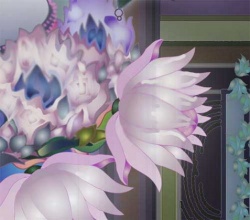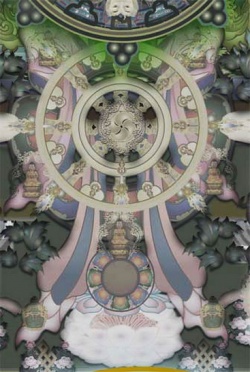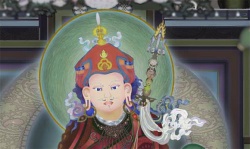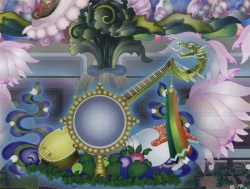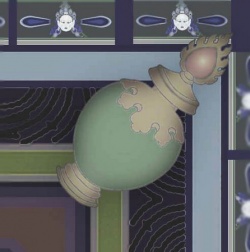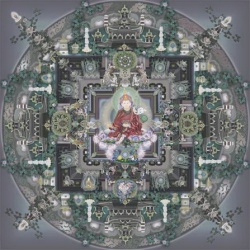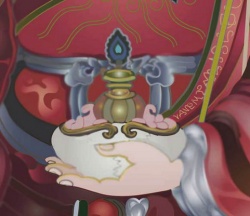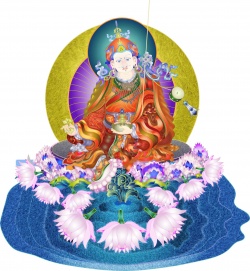A Noble Noose of Methods, the Lotus Garland Synopsis
Methodological Issues in the Study of a Mahāyoga Text from Dunhuang
Cathy Cantwell, University of Oxford and Robert Mayer, University of Oxford
JIATS, no. 5 (December 2009), THL #T5696, 51 pp.
© 2009 by Cathy Cantwell, Robert Mayer, IATS, and THL
Abstract: The Dunhuang manuscript IOL Tib J 321 is a Nyingma tantra commentary in eighty-five folios, the Tapkyi Zhakpa Pemo Trenggi Düpé Drelpa, with its root tantra embedded as lemmata. Marginal notes and a concluding verse of praise associate the work with Padmasambhava. Although cited by Rongzompa and
Longchenpa, later Nyingmapas lost touch with the commentary, available to them only in truncated form within Tengyur editions. The Dunhuang manuscript now enables reconstitution of the entire commentary. More complex is the root text’s transmission. Extant in all Ancient Tantra Collection of the Nyingmapa (Nyingmé Gyübum) and Kangyur Ancient Tantra (Nyinggyü) sections, the
versions can differ substantially, raising fundamental questions of textual boundedness. The differences derive from a thousand years of imprecise differentiation between root and commentary in many major editions, persisting unresolved from Dunhuang times until now despite the survival of correctly bounded ancient versions at
the cultural margins. Nyingma responses to uncertain scriptural boundaries entailed a distributive approach to knowledge, at variance to some modern textual presuppositions.
Introduction
This paper is a brief reflection on the culture of tolerable scriptural variation that we find in Nyingma Buddhism. It raises methodological issues for textual scholars of the Nyingma tantras, which, although specific to Nyingma texts, might also shed useful comparative light on other genres. In
comparing appropriate methodological approaches for the Ancient Tantra Collection of the Nyingmapa and for the Kangyur, the orthodox canonical collection which gained shape in the fourteenth century, we make two main points:
1. While current Kangyur scholarship is, for entirely compelling reasons, in many cases abandoning the hope of recovering unitary original texts or archetypes through philological
analysis, study of the Nyingma canon suggests the opposite. Our admittedly meager analysis so far tends towards the provisional conclusion that Nyingma tantras may often have original redactorial moments, and should, in theory at least, present archetypes recoverable through philological
methods. We certainly do believe we can partly succeed in recovering an archetype of the Tapzhak root text, and will present our evidence for this in a forthcoming book. However, note well that neither the terms “original” nor “archetype” need always imply in the context of tantric texts independence from borrowings from earlier texts or freedom from orthographical or grammatical error! Those are quite different issues.
2. If Kangyur scholarship is currently emphasising the non-unitary and varied nature of texts before their incorporation into Tibetan canons, our work on the Ancient Tantra Collection of the Nyingmapa is currently emphasising diversity after incorporation into Tibetan canons. Hence our second point,
a little ironically, slightly devalues the first. Even if historians of the Nyingmapa might (as we do here to some degree) enjoy the luxury of recovering very early archetypes or even originals through philological methods, this luxury is of partially limited value because the Nyingmapas themselves
do not operate in quite this way. On the one hand, their tantras have come to vary over time through scribal error and piecemeal attempts at correction, or, as in this instance, confusions between root text and commentary; and on the other hand, the Nyingmapa have never sought to establish a centralized authority that could
standardize their scriptures. Nor do they systematically identify or specify in their tantra catalogues the different versions of a text. Of course, there is little problem where one reading is clearly better than another –
bad readings can be eliminated without controversy – but the cumulative effect of centuries of dissociated hypercorrections made without recourse to other editions, leads to an occasional variety of good readings, each equally plausible, each the potential basis of further learned exegesis.
For example, the commentarial tradition on the tantric deity Dorjé Purpa had to make sense of two rather different readings within the root verses on the creation of the deity’s maṇḍala (kyilkhor), even though these root verses are so important that they [page 3] are shared by all the scriptural
texts, and repeated in all major practice texts.2 Hence, despite in many cases apparently starting out with unitary texts or redactorial moments, the Nyingmapa are by now no better off than the Kangyur tradition. They have had to accept that in different editions and in different regions, ostensibly the same versions of important
tantras can vary somewhat, at some points displaying what appear to be equally viable yet different readings. It is true that some Nyingma lamas aware of such discrepancies can sometimes bemoan this lack of uniformity. Yet de facto, for the last many centuries, the Nyingma lamas have had little option other than to live with it.
Perhaps partly making a virtue out of necessity, but perhaps equally because of their ontological beliefs about lamas and tantric texts, many of them do not seem to see this as an unmitigated problem. On the contrary, they seem in practice to have been compelled towards a distributive understanding of knowledge, very like the understanding of Mahāyāna and tantric scriptures that often prevailed in India, in which each sound and meaningful variant version can be appreciated for contributing its partial vision of the
Buddhas’ total authorial intention (bad readings are of course rejected without hesitation as the mistakes of scribes). The point should not be over-stated: lamas will often insist on particular readings established in commentarial traditions in which they have been taught.
Yet they will hesitate to dismiss or criticize alternatives presented by other lamas of different commentarial traditions, and when pressed, may affirm that the alternative readings are valid for that other lineage of descent. To approach this within narrowly political terms: if a lama takes too
strong a stand in rejecting one plausible good reading in favor of another plausible good reading, he incurs the risk of unwittingly challenging some other respected authority. If he could have near-total knowledge of all
previous and present views, then he might be happier to take such a risk, but such complete knowledge is seldom available. What then, if Rinpoché A were to take a radically exclusivist position today, only to find out tomorrow he had in doing so inadvertently labelled Terchen B or Khenchen C as definitely mistaken? The embarrassment could be considerable.
So dogmatism tends to be avoided, and the range of good readings cautiously tolerated. For most Nyingmapa, the perfect [page 4] and complete text of a tantra is not an historical archetype recoverable philologically: it is something that exists only in the tantric heavens or in the guardianship
of the Ḍākinīs, of which extant terrestrial versions, including the philologist’s, are in all likelihood little more than imperfect partial reflections.3 We are not yet certain to what degree and in what way this partly ideological and partly pragmatic view is peculiar to the Nyingma tantras, and to what
degree it pervades other genres as well. We are aware of the variant versions of texts like the Heart Sūtra preserved in the Kangyur,4 and we are equally aware of the perspective of modern scholars like Jonathan Silk and Paul Harrison, who understand Indian Mahāyāna scriptures as
works in constant motion that never indigenously achieved a fixed entity. In addition, we are aware of the works by colleagues in parallel fields, notably the modern Talmudists, who have clarified the way in which anonymous collective scriptural authorship may work on the ground. Nevertheless, we do not want to extrapolate from other fields, but will ensure through careful collations that the Nyingma texts talk to us directly with their own historical message.
[1] We are grateful to the British Arts and Humanities Research Council for providing us with the funding that enabled the research on which this paper is based. We would also like to thank David Germano and the other anonymous reviewer who made comments on an earlier version of this paper. Parts of the paper were presented in 2009
and 2010 as lectures at Harvard, Chicago, Vienna and SOAS (University of London). We would like to acknowledge the comments which arose in the discussions on those
occasions. Furthermore, at the final revision stages, Helmut Eimer and Helmut Tauscher drew our attention to the versions of the Tapzhak found in the Independent Kangyurs of Batang and of Hemis, and these additional witnesses have clarified our picture of the historical transmission of the text.
[2] Generally, commentarial writings will consider only the readings witnessed in the specific liturgical tradition on which they are commenting, but occasionally, variation is acknowledged. Kongtrül’s commentary
on the Dorjé Purpa Tsawé Gyükyi Dumbu (Jamgön Kongtrül Lodrö Tayé, Pel Dorjé Purpa Tsawé Gyükyi Dumbü Drelpa Nyingpo Düpa Pelchen Gyepé Zhellung, in Düjom Kama Bdud-’Joms ’Jigs-bral-ye-śes-rdo-rje Rñin ma Bka’ ma rgyas pa, vol. tha [[[Wikipedia:Kalimpong|Kalimpong]]: Dupjung Lama, 1982-1987], 78-80) explicitly recognizes one variant
in the first root verse (thig le/thigs pa), and implicitly acknowledges another (sgor shar/gor shar), elucidating the text with reference to the alternative connotations. Kongtrül (Kongtrül, Düjom Kama, vol.
tha, 92-93) furthermore draws attention to a contrast between the reading of the Dorjé Purpa Tsawé Gyükyi Dumbu and of Ancient Tantra Collection texts for the second root verse, suggesting they can be understood as variant translations, and reiterating that the significance of these profound vajra words of the root tantras is the same in both cases (bsgyur ba gnyis don ni gong du bshad pa dang ’dra’o; Kongtrül, vol. tha, 92.6).
See the discussion in C. Cantwell, “To Meditate upon Consciousness as Vajra: Ritual ‘Killing and Liberation’ in the rNying-ma-pa Tradition,” In Tibetan Studies: Proceedings of the 7th Seminar of the International Association for Tibetan Studies, Graz 1995, ed. H. Krasser, M. T. Much, E. Steinkellner, and H. Tauscher (Vienna: Österreichische Akademie der Wissenschaften, 1997), 1:115.
[3] Since writing the above, we have noticed David Gray’s article in JIATS (David Gray, “On the Very Idea of a Tantric Canon: Myth, Politics, and the Formation of the Bka’ ’gyur,” Journal of the International
Association of Tibetan Studies, no. 5 [December 2009]: http://www.thlib.org/collections/texts/jiats/#jiats=/05/gray/), which discusses different versions of this mythic ideal throughout Tibetan Buddhism, including the specifically Nyingma version of the revelation of the tantras of Mahāyoga to King Jaḥ. In conclusion, Gray makes the point that the absence of the ideal texts was a factor in preventing absolute canon closure.
[4] J. Silk, The Heart Sūtra in Tibetan: A Critical Edition of the Two Recensions Contained in the Kanjur (Wein: Arbeitskreis für Tibetische und Buddhistische Studien Universität Wien, 1994), 31-41.
Why Ancient Tantra Collection Texts Are so Valuable
The Nyingma or “Ancient” school of Tibetan Buddhism, like the Bön, has the unusual distinction of basing its major tantric systems upon scriptures largely excluded from the Kangyur. The Nyingma response was to consolidate their tantras within their own compilation known as the Nyingmé Gyübum, or the
Ancient Tantra Collection, a process that achieved increasing maturity in the fifteenth century. In its fullest editions, this collection nowadays includes around one thousand works, in about thirty-five thousand folios, or seventy thousand pages. The provenance and authenticity of the Nyingma tantras has been questioned in
various ways from the turn of the eleventh century until the present day. Some considered them translated from Sanskrit, hence authentic; others considered them Tibetan compositions, hence inauthentic. Yet others, including the famous eleventh century Nyingma sage [[Rongzom
Chökyi Zangpo]], seemed to accept the possibility that they were compiled in Tibet, yet nevertheless deemed them authentic.5 Either way, the Nyingma tantras have had, and continue to have, a very powerful influence on Tibetan religion.
Ancient Tantra Collection scriptures often become more widely known through references reproducing citations given in important commentarial works,6 rather than through direct reading of the source texts, although learned lamas certainly could, did, and still do, have direct recourse to scriptural texts.
The genre comes into view in the post-Imperial period. Modern academic analysis, including our own, finds that most Nyingma scriptures studied so far resemble what Davidson7 has dubbed “gray” texts. Neither wholly Indian nor wholly Tibetan, they are Tibetan compilations in the style of Indian tantrism comprising predominantly Indic materials with some Tibetan admixture and localization.
Our most reliable sources for the early Nyingma are of course the Dunhuang Tantric texts. Recent research on them reveals a sophisticated and complex tantrism demonstrably continuous with the Nyingma tantrism of later centuries, although with interesting differences too. More specifically, detailed comparative examinations
of Dunhuang tantric materials with texts from the Ancient Tantra Collection now shows with certainty that the Ancient Tantra Collection does indeed conceal within its vast bulk a great deal of genuinely pre-Sarmapa Tantric materials.8 For those interested in studying the early history of Tantric Buddhism in Tibet, the Ancient Tantra Collection is thus potentially a treasure trove of information.
[5] Many (although not all) of these tantras are presented with Sanskrit equivalent titles and colophons naming one or more of the illustrious figures from the traditional historical accounts of the early
transmissions as translators. Some later Nyingma voices argued that these texts were indeed verbatim translations from Sanskrit originals from the reign of Tri Songdeutsen. By contrast, much (not all) modern scholarship locates them somewhat later, mainly after the collapse of empire around 842.
Interestingly, the criterion of Indian provenance used by the compilers of the Kangyur to judge the authenticity of a tantra was not always fully accepted by Nyingmapa scholars, such as the influential Rongzompa. As Dorji Wangchuk puts it (Dorji Wangchuk,
“An Eleventh-Century Defence of the Authenticity of the Guhyagarbha Tantra,” in The Many Canons of Tibetan Buddhism, edited by D. Germano and H. Eimer [[[Leiden]]: Brill, 2002], 282), “Rong zom pa’s response… does not categorically rule out the possibility of the tantra being a compilation or a composition by a Tibetan
scholar… but rather addresses his opponents from a stance of spiritual ethics, trying to persuade them that in spite of such a possibility, one should approach the text with reason and respect on the basis of its scriptural coherency.” Wangchuk presents some passages from Rongzompa’s work; perhaps most pertinent is
the point that the Buddhas need not be restricted by time or place, or to superior Buddha-like bodies, but arise in response to the needs of sentient beings. Thus (in Wangchuk’s translation), “even if tantric treatises are taught with overlaps and so on, and even if it is possible that they were compiled and
composed by (Tibetan) Upādhyāyas, they should not be considered objects of doubt, for the ways the blessings of the tathāgathas appear are not restricted” ([[rgyud kyi gzhung ldab bu la sogs par ston pa dang / gal te mkhan po rnams kyis bsdus shing sbyar ba srid na yang / de bzhin bshegs pa’i byin gyis rlabs byung ba la tshul nges pa med pa yin pas the tshom gyi yul du bya ba ma yin no/]]; Wangchuk, “Eleventh-Century Defence,” 283-284).
[6] C. Cantwell and R. Mayer, The Kīlaya Nirvāṇa Tantra and the Vajra Wrath Tantra: Two Texts from the Ancient Tantra Collection (Vienna: The Austrian Academy of Sciences Press, 2007), Ch. 2.V.
[7] R. Davidson, “Gsar ma Apocrypha: The Creation of Orthodoxy, Gray Texts, and the New Revelation,” in The Many Canons of Tibetan Buddhism, edited by D. Germano and H. Eimer (Leiden: Brill, 2002), 212.
[8] Our work on the Dunhuang texts relating to the tantric purpa practices demonstrates substantial passages in common between the Dunhuang materials and Ancient Tantra Collection of the Nyingmapa texts. See especially C. Cantwell and R. Mayer, Early Tibetan Documents on Phur pa from Dunhuang (Vienna: The Austrian Academy of Sciences Press, 2008), chapters 5 and 6.
Textual Obscurity and Scribal Corruption in the Extant Ancient Tantra Collection
Tibetology has known the historical potential of the Ancient Tantras since Rolf Stein’s time, yet use of them has remained slight, because they are so difficult to consult. One major problem is the lack of commentarial literature: only a very small proportion of Ancient Tantra Collection texts have extant commentaries, so that the root verses on their own frequently remain obscure even to the most learned lamas.
Another problem is scribal corruption. We know from comparisons with Dunhuang manuscripts that much of the material in these texts is around one thousand years old, ample time for scribal errors to appear. When editing two Ancient Tantra Collection texts some years ago, we found around one word in three differing
between our six witnesses. If punctuation was included, there was a statistical average of one variant for every three or four syllables. In addition to such small-scale variants, there are also larger ones, where longer passages, whole folios and entire chapters can vary, be lost, misplaced, or otherwise jumbled. Complete chapters can differ immensely across the different editions, to the extent that the average reader might wonder if they are the same text at all.
When faced with such textual difficulties, Tibetan lamas, like their Western counterparts, seek out other editions. Before the Cultural Revolution, there were undoubtedly more versions than there are today. As the major repository of their scriptural tradition, every major Nyingma monastery once held a copy of the
Ancient Tantra Collection, and several hundreds must have existed in the 1950s. Yet after the Cultural Revolution, only a handful are still available: four from Bhutan which are almost identical, a xylograph edition from Degé in East Tibet, and four manuscripts from northern Nepal and Southern
Tibet which are related to one another. In short, we can currently muster only nine witnesses, representing three distinct traditions, and with the exception of the Degé xylograph, mainly drawn from the geographical
peripheries of the Tibetan cultural region. Many famous manuscript editions of the past seem to have been lost, such as the collection made by Ratna Lingpa in the fifteenth century, or Jikmé Lingpa’s eighteenth century edition, and the library copies from major Nyingma centers like Mindrölling and Katok have not yet reappeared, and might not have survived at all.
